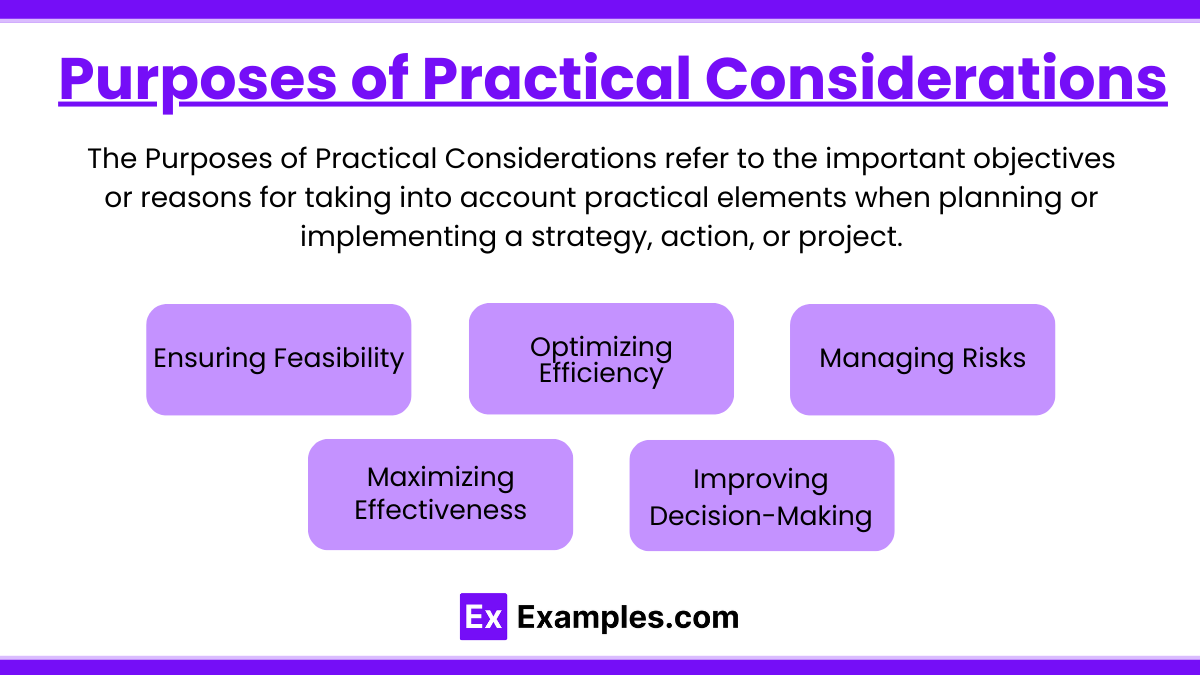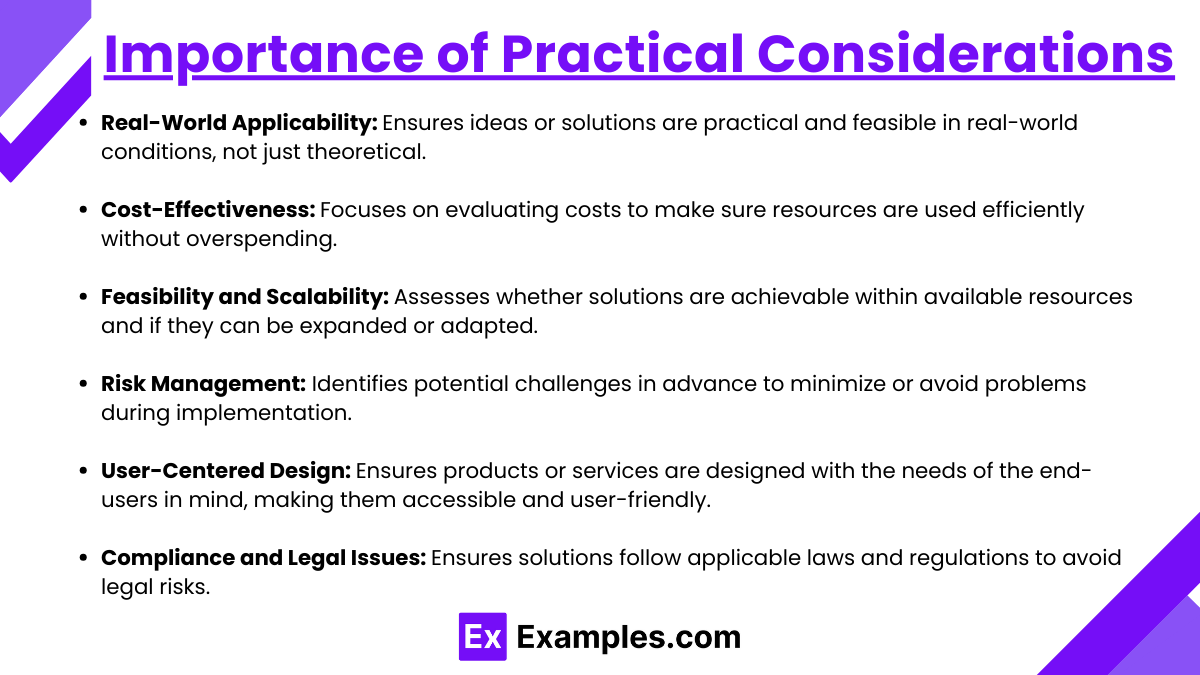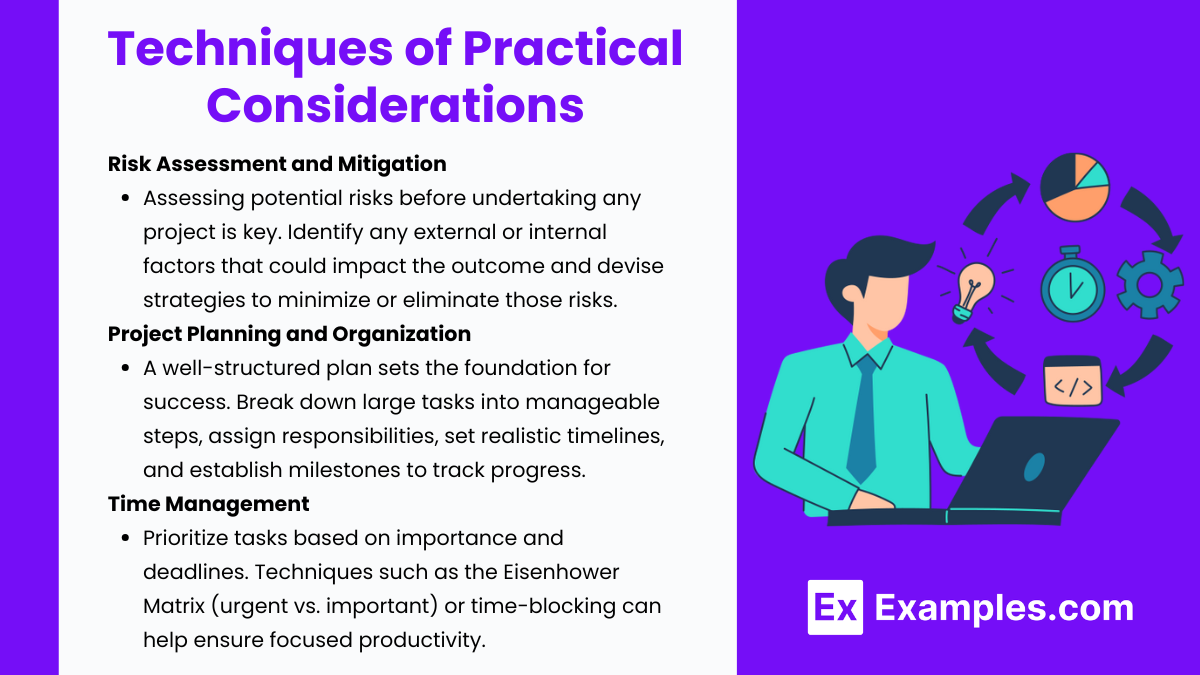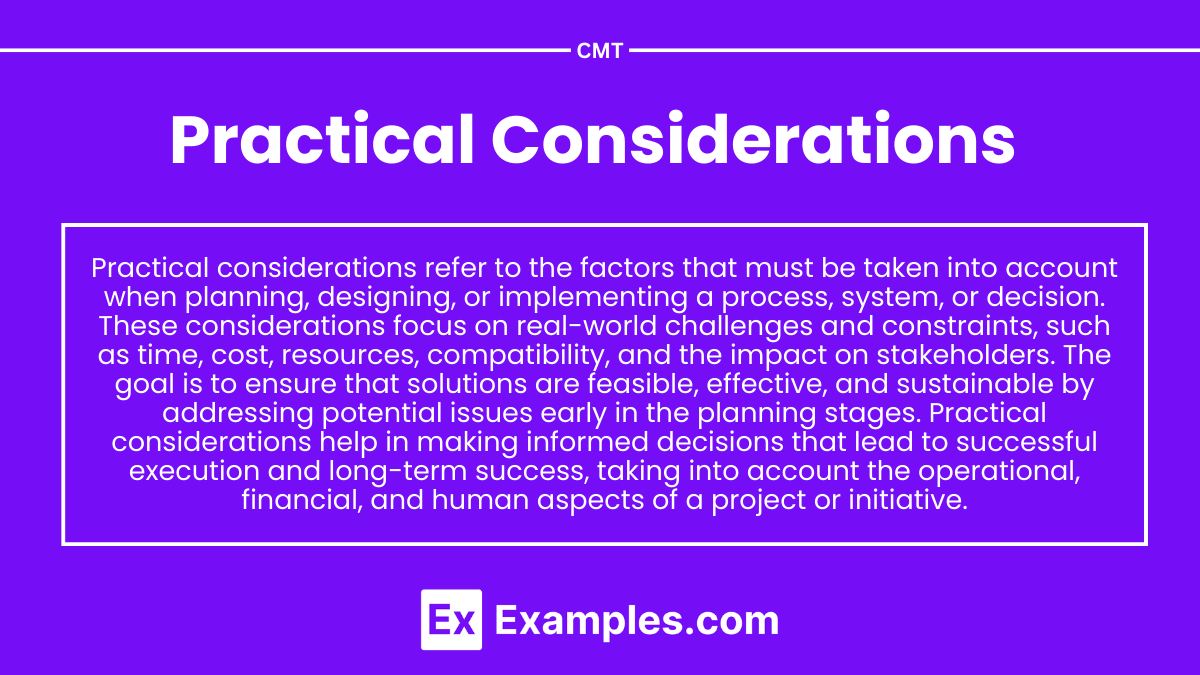Preparing for the CMT Exam requires a solid understanding of the “Practical Considerations” involved in applying technical analysis effectively in real-world market conditions. This involves analyzing various factors such as market liquidity, risk management, and the impact of macroeconomic trends. Additionally, candidates must be familiar with trade execution strategies, backtesting methodologies, and portfolio optimization techniques to adapt to changing market environments. Mastering these practical considerations helps candidates identify potential pitfalls, refine trading strategies, and effectively manage risks, ultimately contributing to more successful trading decisions.
Learning Objectives
In studying Practical Considerations for the CMT Exam, you should learn to understand their importance in applying technical analysis in real-world trading. Successful consideration involves evaluating market conditions, assessing liquidity risks, and understanding the effects of economic shifts on strategies. Techniques such as risk management, trade execution optimization, and portfolio diversification are crucial. By mastering these methods, candidates can enhance their ability to adapt to market dynamics, manage risks effectively, and ensure consistent portfolio performance, which is essential for success in the CMT Exam.
Purposes of Practical Considerations

The Purposes of Practical Considerations refer to the important objectives or reasons for taking into account practical elements when planning or implementing a strategy, action, or project. These considerations help ensure the feasibility, efficiency, and effectiveness of the process. Below are some key purposes of practical considerations:
- Ensuring Feasibility
Practical considerations help determine if a plan or action is achievable given the available resources, skills, and constraints. - Optimizing Efficiency
By considering practical factors, one can identify ways to streamline processes, reduce waste, and save time and money. - Managing Risks
Practical considerations help assess potential risks and challenges that might arise and allow for the creation of strategies to mitigate these issues. - Maximizing Effectiveness
These considerations ensure that the chosen approach will produce the desired outcomes in the most efficient and effective way possible. - Improving Decision-Making
When practical considerations are integrated into decision-making, it helps ensure that decisions are made with a realistic understanding of what is possible.
Importance of Practical Considerations

Practical considerations are crucial in various fields, from business to healthcare and engineering. These factors focus on the real-world applicability, feasibility, and functionality of ideas, plans, or systems. Understanding and addressing practical considerations ensures that solutions are not only theoretically sound but also effectively implemented in actual conditions. Here’s why they are important:
1. Real-World Applicability
Practical considerations ensure that ideas or solutions can be applied in the real world, where conditions might differ from theoretical assumptions. For instance, a product might look great on paper, but if it’s too costly or difficult to manufacture, it won’t be viable.
2. Cost-Effectiveness
When making decisions, it’s essential to consider the financial aspect of implementation. Practical considerations include evaluating costs associated with materials, labor, and time. This helps prevent over-expenditure and ensures that resources are used efficiently.
3. Feasibility and Scalability
Solutions must be achievable within the given resources and constraints. Practical considerations help assess whether the proposed solution can be scaled up to meet larger demands or adjusted for varying situations.
4. Risk Management
Identifying potential risks and challenges before implementing a solution is crucial. Practical considerations allow for the anticipation of obstacles, enabling preemptive action to mitigate issues that could hinder progress.
5. User-Centered Design
Solutions must also meet the needs of the end-users. Practical considerations help ensure that products or services are user-friendly, safe, and accessible, taking into account the diverse needs of different user groups.
6. Compliance and Legal Issues
Practical considerations often involve ensuring that solutions comply with relevant regulations and laws. This is particularly important in industries like healthcare, finance, and construction, where non-compliance can lead to legal consequences.
Techniques of Practical Considerations

When approaching practical considerations, it’s crucial to implement effective techniques that ensure success, efficiency, and minimal risk. Below are several techniques commonly used:
- Risk Assessment and Mitigation
Assessing potential risks before undertaking any project is key. Identify any external or internal factors that could impact the outcome and devise strategies to minimize or eliminate those risks. - Project Planning and Organization
A well-structured plan sets the foundation for success. Break down large tasks into manageable steps, assign responsibilities, set realistic timelines, and establish milestones to track progress. - Time Management
Prioritize tasks based on importance and deadlines. Techniques such as the Eisenhower Matrix (urgent vs. important) or time-blocking can help ensure focused productivity. - Resource Allocation
Optimize the use of resources by ensuring that they are used efficiently. Allocate appropriate time, people, and budget to each task or project based on its importance and urgency. - Communication and Collaboration
Effective communication among all team members and stakeholders is essential. Keep everyone informed through regular updates, meetings, and clear documentation. - Quality Control
Consistently monitor and evaluate the quality of work throughout the process to ensure standards are maintained. Use quality assurance techniques like checklists or regular inspections to identify any issues early on. - Adaptability and Flexibility
Being able to pivot or adjust the approach when unforeseen circumstances arise is crucial. Build flexibility into your planning so that adjustments can be made quickly and efficiently when needed. - Feedback and Improvement
After the completion of a task or project, conduct reviews to gather feedback. Identify areas for improvement and apply those insights to future projects to enhance overall performance.
Examples
Example 1. Using Practical Considerations in Financial Planning
When creating a comprehensive financial plan, practical considerations such as current financial obligations, future financial goals, and risk tolerance must be carefully evaluated. Assessing income sources, savings capacity, and potential tax implications is essential to develop a sustainable plan. Practical considerations ensure that the financial strategies put in place are achievable and aligned with the individual’s financial circumstances, making it a realistic and effective tool for long-term financial health.
Example 2. Using Practical Considerations in Project Management
In project management, practical considerations like available resources, team skills, and project timelines play a vital role in determining the scope and success of a project. Understanding constraints such as budget limits and potential delays helps in adjusting expectations and planning realistic milestones. By incorporating practical considerations into the planning phase, project managers can avoid overcommitting and ensure that objectives are met without compromising quality.
Example 3. Using Practical Considerations in Healthcare Decision-Making
In healthcare, practical considerations such as patient preferences, available treatment options, and the healthcare system’s resources must be taken into account when making decisions. Medical professionals need to balance theoretical knowledge with the real-world challenges patients face, including financial limitations and access to care. Incorporating these practical factors ensures that treatment plans are both effective and accessible to the patients, improving health outcomes and patient satisfaction.
Example 4. Using Practical Considerations in Environmental Conservation
Environmental conservation efforts often require practical considerations like local climate, available technologies, and community involvement. While theoretical models of environmental protection are valuable, their implementation must account for regional challenges such as population density, economic conditions, and cultural practices. By using practical considerations, conservation strategies can be more adaptable and successful, promoting sustainable environmental practices that are feasible within local contexts.
Example 5. Using Practical Considerations in Marketing Campaigns
Effective marketing campaigns rely heavily on practical considerations such as target audience demographics, marketing budget, and timing. Marketers need to assess the real-world impact of their strategies by understanding consumer behavior and market trends. Using practical considerations allows marketers to fine-tune their campaigns, ensuring they are not only creative but also financially viable and targeted to the right audience, maximizing the return on investment.
Practice Questions
Question 1
What is the most important practical consideration when designing a new process or system?
A) Cost of implementation
B) Time required for training staff
C) Potential for scalability
D) Compatibility with existing systems
Answer: D) Compatibility with existing systems
Explanation: When designing a new process or system, ensuring compatibility with existing systems is crucial because it minimizes disruptions and integrates smoothly into the current workflow. Compatibility issues can lead to costly delays, inefficiencies, or even failure of the system. While cost, time, and scalability are also important, compatibility is often the first hurdle to overcome.
Question 2
Which of the following is a practical consideration in change management?
A) The speed at which the changes can be implemented
B) The level of support from stakeholders
C) The number of changes required
D) The design of the change communication strategy
Answer: B) The level of support from stakeholders
Explanation: The level of support from stakeholders is essential in change management, as it directly influences the success of the change process. Stakeholders, including employees, managers, and clients, need to be engaged and supportive for the change to be successful. While speed, the number of changes, and the communication strategy are important, stakeholder support is the foundational element that drives the process forward.
Question 3
Which of the following practical considerations is most relevant for risk management?
A) Predicting every possible risk
B) Identifying and prioritizing risks based on impact and likelihood
C) Ignoring low-impact risks to focus on high-impact ones
D) Relying solely on external audits for risk assessment
Answer: B) Identifying and prioritizing risks based on impact and likelihood
Explanation: In risk management, it is essential to identify and prioritize risks based on their potential impact and the likelihood of occurrence. This allows for a more focused and resource-efficient approach to managing risks. While it is not possible to predict every risk, nor should low-impact risks be ignored, prioritization ensures that resources are allocated effectively to mitigate the most significant risks. Relying solely on external audits is also insufficient for comprehensive risk management.


